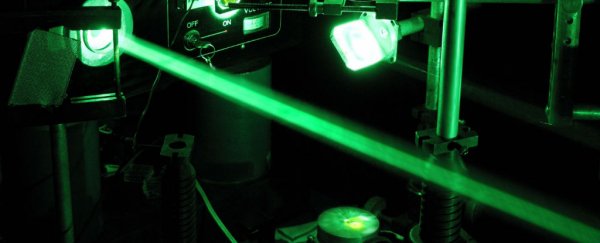Scientists say they've successfully tested a new US$48 million 'super laser', and they're claiming it's 10 times more powerful than any other laser of its kind on the planet, with an average power output of 1,000 watts.
If that doesn't sound all that powerful to you, you're right - there's a laser in Japan that can hit peak outputs of more than 1 trillion watts. But this new pulse laser doesn't blow everything on a single burst - it can reportedly fire high-powered beams many times over, and with more power than any other technology on the planet.
The laser has been built by Britain's Central Laser Facility (CLF), and HiLASE (High average power pulsed laser), a Czech state research and development project run by the country's Institute of Physics.
"It is a world record which is important," director of the CLF, John Collier, told AFP.
"It is good for putting things on the map, but the more important point is that the underlying technology that has been developed here is going to transform the application of these high power, high energy lasers."
Let's get one thing straight right off the bat - a world record is a mighty big claim, and the team has yet to release a peer-reviewed paper to support it. So until the numbers are independently verified, we'll have to take their word for it, but it's by no means official.
But the Czech researchers have had a plan in place to hit this specific record since 2011, and Central Laser Facility has been developing laser technology for over four decades now, and currently have five active laser labs in operation, so these are not new players in the laser game.
The team claims to have achieved the record last month at a testing facility in Dolní Břežany - a municipality near Prague in the Czech Republic.
Their DiPOLE 100 laser (nicknamed Bivoj, after a Hercules-like hero in Czech mythology), reportedly hit an average of 1,000 watts for over 1 hour without intervention, and the team asserts that this kind of sustained, high-energy pulsing is unrivalled.
When we talk about the world's most powerful lasers, there are two very different types - there are continuous lasers, which fire constant beams of energy, and there are pulse lasers, which can fire in short, powerful bursts.
The DiPOLE 100 is a pulse laser, and the two other largest high-power pulse lasers in existence are the Texas Petawatt Laser in Austin, and the 2-petawatt Laser for Fast Ignition Experiments (LFEX) in Osaka, Japan.
Those lasers "have a very high peak power, but they can only reach it several times a day," HiLASE director Tomas Mocek told AFP.
"They do not have so-called average power. This is a combination of the repetition rate and the energy. Our laser has the highest average power, which is important. The repetition rate in Osaka and Austin is significantly lower."
What's really cool about this announcement - if it can be confirmed in a published paper - is that it adds a new kind of diversity to the world's best high-powered pulse lasers, and could be really useful for researchers of the future.
So while the Texas Petawatt Laser could be used to run a couple of experiments per day, helping researchers peer into exotic states of matter and ultra-high electromagnetic fields, the DiPOLE 100 provides a constant stream of highly focussed laser energy for things like particle acceleration and X-ray generation.
The team plans on commercialising it by the end of 2017, so let's hope some great science comes of it.
For more information on the project, you can check out HiLASE's plan for the laser, and this 2015 paper published in Optics Express on the first iteration of the DiPOLE 100.
